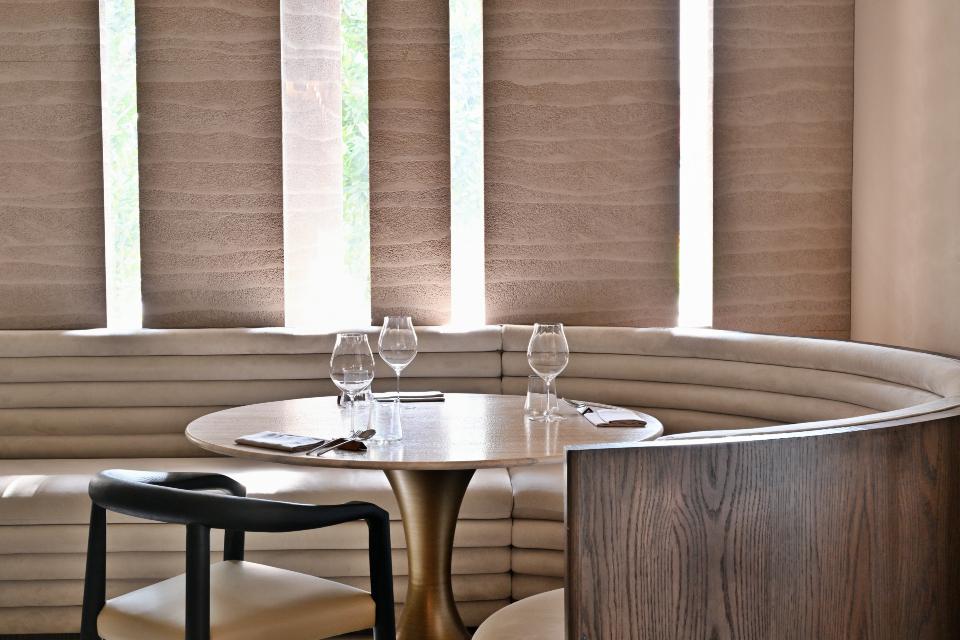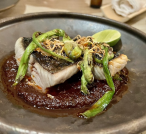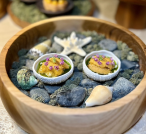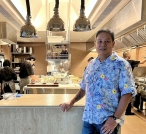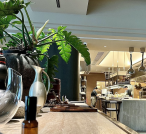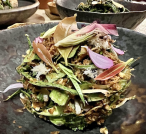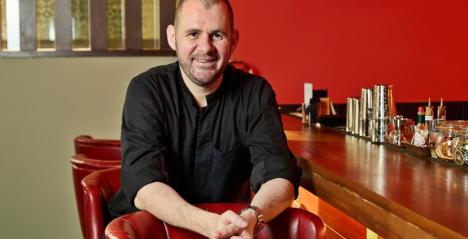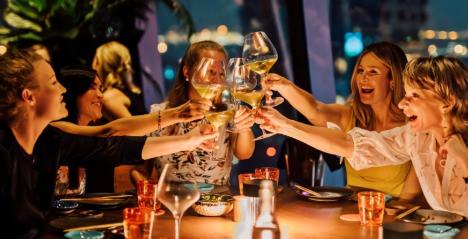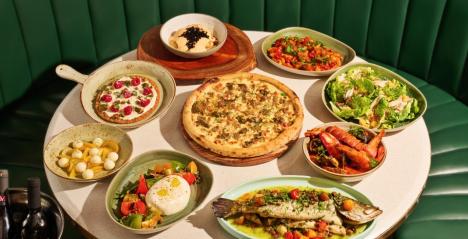Restaurant Fiz joins Tanjong Pagar’s growing list of fine dining restaurants. Adding its own vision to the neighbourhood, it spotlights regional dishes, forgotten indigenous ingredients and ancient ways of cooking in tasting menus that showcase the cuisines of Southeast Asia. The restaurant is Chef-Owner Hafizzul Hashim’s opus to the boundless beauty of the region. It is vast and purposefully diverse in its scope, sweeping across food cultures from the ancient steps of Angkor Wat to the lush highland valleys of Sarawak.
The result is a gastronomic oeuvre that draws from the knowledge of societies past and present, experienced through a series of menus that convey the warmth and comfort of communal dining while retaining a contemporary identity.
“Southeast Asia has so much to offer,” says Chef Hafizzul. “It is possibly one of the most diverse regions on the planet with an abundance of culinary cultural traditions that deserves its time in the spotlight.”

Born in Kuala Lumpur to Malay and English parents, Chef Hafizzul was raised in the coastal town of Lumut in Perak. He started working in commercial kitchens in his home city of Kuala Lumpur at 18. Over the decades, he has made his career in London, Tokyo and Ho Chi Minh and donned Chef whites for a number of Michelin-starred restaurants like Mirabelle and Chez Bruce in London as well as Jean Georges Tokyo.
It was there in the bustling Japanese capital that the first lightbulb went off. “We used a lot of Thai and Japanese flavours in the menu at JG Tokyo,” explains the Chef. “I realised then that high end restaurants were using ingredients that I grew up with — like makrut (kaffir) lime leaves and galangal. It prompted me to start thinking about my oldest vision of food: to dive into Southeast Asian cuisine and present a version that speaks to the diners of today.”
Inspired, Chef Hafizzul travelled around mainland Southeast Asia for research and insight. That included sojourns to markets and eateries from Luang Prabang to Siem Reap and he made it a point to amass a library of books, even procuring ancient culinary manuscripts compiled by writers who recorded the historical dishes served in royal and noble houses. This extensive research augments one of his earliest career experiences where he gleaned recipes from the chefs of Malaysia’s royal courts.
“The ‘bangsawan’ — or royal families and the people affiliated with the monarchies — are custodians of culture,” says the Chef. “It is in the royal courts that old traditions and cultural customs are preserved, practised and refined. That’s where food finds its highest form of expression.”

At Restaurant Fiz, Chef Hafizzul combines his comprehensive research around Southeast Asia with the knowledge inherent from his upbringing and his professional culinary training. The region is home to a diverse slate of cuisines, yet the common use of indigenous ingredients is the spindle that forms the culinary thread of the region. The difference, says the Chef, is in the ratios — and the dishes of Chiang Rai can spring forth as much as the dishes of Palembang from the same basket of ingredients.
To honour these geocultural nuances, Restaurant Fiz will introduce menus every three to six months known as Episodes which will put a different region under the magnifying glass. Ep. 1 [$288++ for 8 courses exclusive of supplement] will be an intimate introduction to Chef Hafizzul’s background, encompassing his childhood and the food closest to him as a young man growing up in Lumut.
Many of these dishes hail from the Malay peninsula’s coastal regions, where the seas lap against lush tropical jungles. He relies deeply on “air tangan” a Malay phrase which means “water from the hand”, where food is cooked with instinct, finesse, and heart. These dishes are crafted in the old ways, and the kitchen relies on charcoal as the primary source of heat, particularly bakau wood. This variety is derived from the indigenous mangrove trees that hug Southeast Asia’s coastlines and is prized for burning hotter and longer, while being far more sustainable as it is fast-growing and can be sourced locally.

Growing up, Chef Hafizzul spent a large part of his childhood foraging by the shore and hunting for local venison or wild fowl in the jungles with his father. The meal thus begins with a quartet of snacks centred around the gifts of the sea. The Murasaki Uni is served on a jelly made of sinigang, a clear fish broth that is mildly piquant and finished with kesum leaf oil.
The Firefly Squid is a distillation of the elements of his mother’s nasi lemak recipe served in a pie tee shell. Here, coconut rice espuma is paired with a sambal cooked with house-made coconut oil, that has been split from coconut milk then topped with an aged firefly squid.
Besides life by the shore, the Chef also enjoyed frequenting pasar malams (night markets) in the evenings where streetside hawkers would be grilling, basting and smoking up a rambunctious feast. Amongst his favourite snacks are satay kerang where skewered blood cockles dripping with marinade are grilled over charcoal and eaten with peanut sauce. This finds its way in the Blood Cockle, a morsel of akagai from Hokkaido, which is grilled, sliced thinly and then served in its shell with a sambal made from roasted macadamia nuts and finished with turmeric leaf oil.

The same inspiration is seen in the Quail which takes its cue from ayam percik, or chicken marinated in a spice paste then cooked low and slow over a smoking charcoal grill. At Restaurant Fiz, Coturnix quail from Brisbane, Australia — loved for its plump unctuousness — is hand-minced then marinated with herbs and spices before it is shaped into an orb around the chicken leg bone. This is then grilled in a custom-built Josper oven fed with herb trimmings to impart an herbaceous smoky note and continuously basted with fresh coconut milk using stalks of bruised lemongrass.
The meal progresses with the Blue Swimmer Crab that recalls the gulai lemak chilli padi (yellow curry made with coconut milk and turmeric) that Chef Hafizzul enjoys at home. This dish is emblematic of Malay cuisine which shares a close kinship with nature and respect for its bounty. At the same time, it pays homage to his late grandmother who would cook with the freshwater fish that Hafizzul and his father would haul home from a day of fishing.
Here, the crab is deshelled and poached in the coconut milk with aromatics, then served on a luscious, creamy stew made from a crab stock. The coconut milk is procured from a vendor in Geylang Serai Market who uses three types of coconut varieties to yield milk that has the right creaminess, floral aroma and subtle natural sweetness.

From the highlands comes the Rice — and guests get to choose between two forgotten indigenous varieties known as Beras Adan and Beras Sia, procured from farmers of the Lun Bawang community who tend their crops in the highlands between Sabah, Sarawak and North Kalimantan. This honours the local nature of the cuisine and Chef Hafizzul wields forgotten ingredients with a confident hand, working with small growers of heirloom varieties.
The meal comes to a delicate end where traditional Malay Kuih-muih (confectionery) are placed in antique lacquered rattan baskets sourced from Malacca. Diners will be treated to bahulu, kuih serimuka jagung (steamed glutinous rice topped with sweetcorn custard) and kuih badak berendam (glutinous rice balls stuffed with grated coconut flavoured with palm sugar and served in a smoked coconut sauce). These not only showcase ingredients that characterise the Southeast Asian dessert lexicon, but also exemplifies the notion that Malay confectionery symbolises the colour of the earth.
A curated beverage program compliments the meal. The restaurant has put together a strategic list of wines, cocktails, non-alcoholic cocktails and teas that guide guests deeper into their dining experience.

The dish’s symbolism and connection to the earth extend to the restaurant’s interiors. Designed by Akira Kita, the space is a vision of monastic simplicity which harmonises iconic motifs from Southeast Asia’s places of faith and is interpreted through natural and earthy materials of stone, wood, and terracotta.
Every diner experiencing a meal here will tread on the few steps that recall the motions of walking up the places of faith and be welcomed through a commanding wooden door inscribed with an abstract reading of the intricate textures and motifs found in temples across the region.
Inside and at the heart of Fiz lies the main dining area, anchored by a monolith which functions as a central service station. This design element is meant to echo the meditative, circular walk around sacred shrines seen in many Southeast Asian temples and is also a gentle nod to the Kaaba in Mecca, the Chef’s religious roots.
Across the space, circular booths reinforce the circumambulating motion and seats are upholstered in natural tactile fabrics with curves and levels that reflect the contours of Southeast Asia’s terraced landscapes on which rice is cultivated.
The juxtaposition between the dining table and the ceiling is an art in itself. Each dining table is made of antique-finished silver travertine and diners can gaze upon the natural lines and variations within the stone that resembles the undulating terrain of the earth. Look up and diners will find a ceiling built as a tribute to the vaulted ceilings of temples, where angled coves and vaults are fashioned into modern, geometric interpretations. In tandem, it is designed for the diner to look upon the table as the earth and to the skies as the divine.
“Restaurants can certainly be more than just about feeding oneself,” says the Chef. “It can be about honouring culture and history, where identity is embellished and where diners leave with their appetites satiated and their minds enlightened.”
a. 21 Tg Pagar Rd, #01-01/02, Singapore 088444
fb. www.facebook.com/restaurantfiz.sg
You May Also Like

